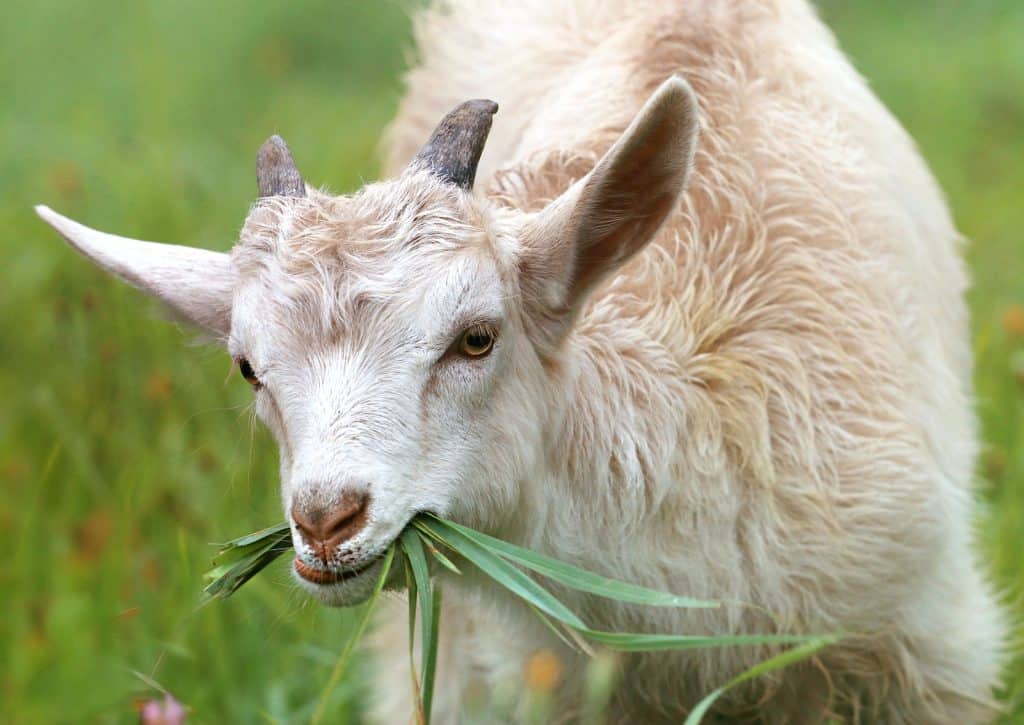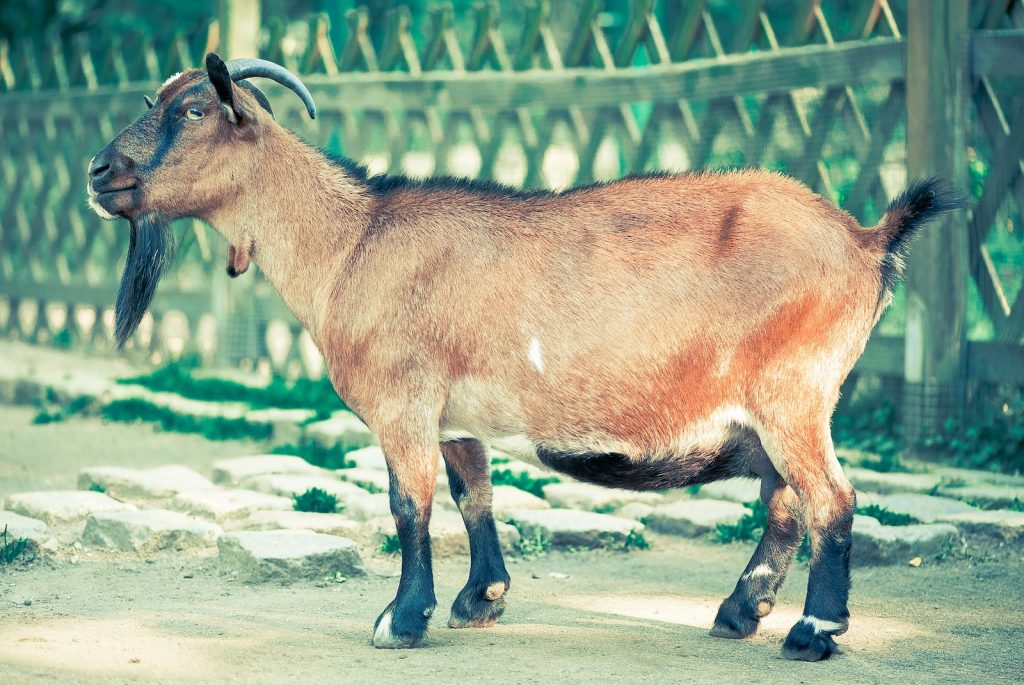
Anglo-Nubian goats were once the main goat that was raised for milk. They are still one the most loved dairy goats in America. Although they don’t produce as much milk as other dairy breeds, their milk has a higher fat content and a better flavor. This breed is native to Britain and was developed with large, Indian, Middle East, and Northern African goats.
They are a very popular breed of goat and can be found in over 60 countries. Nubians can be used for milk, meat, or hide.
Here are some quick facts about Anglo-Nubian Goat
| Species Name: | Capra aegagrus hircus |
| Family: | Bovidae |
| Care Level | Simple |
| Temperament: | Easy to handle, friendly, and affectionate |
| Color Form: | Solid and particolored black, red or tan on White |
| Lifespan: | 12-15 Years |
| Size: | 30 inches in height and 135-175 lbs in weight |
| Diet: | Herbivorous |
| Minimum Enclosure Size: | 200 square feet per goat |
| Compatibility: | Humans and animals are treated with kindness and respect |
Anglo-Nubian Goat Overview

Anglo-Nubian goats are multi-purpose and well-known for their delicious milk. However, their large size allows them to be used for hide production as well as meat production. Their milk has the highest butterfat content, surpassing only the Pygmy, Nigerian dwarf, and Boer breeds. Their milk is ideal for cheesemaking because it has a unique and sweet flavor.
They are strong, sturdy animals that can pull heavy loads and even pull carts. They are friendly, curious, and docile, making them popular pets as well as animals for production. These goats are social animals and thrive on human interaction. They love being stroked and petted.
What is the cost of Anglo-Nubian goats?
Nubian goats are a common species and are relatively affordable to buy. An Anglo-Nubian goat will typically cost $300-$800 depending on availability and breeder.
The Typical Behavior and Temperament
These goats are one of the most friendly breeds of goats. They will soon become a friend with your family. They love to interact with people and will bleat for attention whenever they can, even when they are kept in large groups. They are very active and can thrive in large spaces with plenty of room to roam and forage.
Warning: These goats can be very loud and will often vocalize when they are sad, happy, excited, scared, or excited. They are not suitable for pets if they live near their neighbors. This is an important consideration, as you will ideally need more than one goat. The noise can quickly build up.
Appearance
One of the most striking characteristics of the Nubian goat is its distinctive bell-shaped, long, pendulous ears. They can reach up to one inch above their faces. You can find them with short, glossy, slightly glossy coats, which come in many colors, but the most common are black, red, and white.
These large goats can weigh between 135-175 lbs and are typically 30-35 inches in height. Their convex muzzle is often called a “Roman nose”, and they have small, pointed beards. They are well-known for their fast growth rate, which is why they are so popular in meat production.
How to Care for Anglo-Nubian Goats
Nubians require the same basic care as other goat breeds. They are relatively easy to take care of and require little extra attention. These include adequate shelter, ample space, and freedom, as well as good-quality food, water, and good quality food.
Shelter
They will need shelter to sleep in, to keep them warm and cool in winter and summer, as well as protection from wind and rain. If they feel the need for privacy, this space can also be used as their private space. It should be constructed from wood and have plenty of ventilation. It should be well-insulated in winter if you live in colder climates. You should provide soft bedding for your shelter, such as straw or hay. This will be necessary to change it regularly. The shelter should have a door you can latch. This will keep them inside in bad weather, while you’re gone, and also allows you to separate two goats if necessary.
Attachment
Nubian goats require 200 square feet per goat, but more space is better. While this is acceptable for short periods, these goats will be most happy if they have plenty of room to roam and forage. Although they can be left alone, they will eat anything.
Nubians are skilled escape artists and will need shelter to sleep in and high-quality fencing. As this is the best way for them to be contained, we recommend that they use electric fencing. These agile animals can scale even high-quality fences. A simple, portable electric wire powered by a car battery is the best option.
Accessory
Nubians are social, playful animals who need lots of entertainment. They will happily come to your door and bleat to let you know when they are bored. They should have shade from small trees and shrubs, and rock or scaffolding to climb up on. If they are not allowed to roam free, this is a must.
Are Anglo-Nubian goats compatible with other pets?
Anglo-Nubians can be friendly and sociable with humans, dogs, cats, and other goats. They are friendly, gentle, and easy to get along with. Multiple males paired up with one female is the only problem. To avoid fighting, it is best to keep the males and females apart when you are ready to breed.
How to feed your Anglo-Nubian goat
Any goat owner will tell that these animals will eat anything. These animals are tough and can survive on even the most basic foods. Your goats must be fed a regular diet of high-quality hay in winter to ensure their health and happiness. They also get their nutrients from the range. Whole grains, unprocessed, are a great option for their diet. However, it is important to limit the number of grains they consume as too many can cause digestive problems.
Nubians love snacking, so you can have a variety of treats. You can snack on fruits, vegetables, and leafy leaves as an occasional snack. Garden scraps and weeds can be a great option for goats who don’t have much space. These greens are full of nutrition and will delight them.
How to Keep Your Anglo-Nubian Goat Happy
The Nubians are generally healthy and strong with very few health problems. They can live up to 15 years in some cases. This is true even if the Nubians are given ample space and a varied diet. If livestock animals are left free-range, they can be susceptible to ticks and mites, depending on where you live. However, it is possible to dip them in commercial tick solutions occasionally.
Breeding
Nubians are prolific breeders. Both males and women can reproduce as young as seven weeks of age. This is strongly discouraged and females should not be bred before 8 months. They reach full maturity around 2 years of age, and females can start to milk at their maximum potential at this time.
The Nubian breeding season runs from July to December and lasts for 150 days. Although females can have up to five children at once, it is more common for them to have two or three. Nubians make excellent mothers and are very affectionate and caring toward their children.
Are Anglo-Nubian Goats suitable for you?
Nubian goats are an excellent choice if you’re looking to add goats to your homestead or farm. Nubians are very easy to take care of and require little maintenance. They are friendly, affectionate, and calm animals, which makes them great for children. These goats also produce the best goat milk anywhere and are great as meat animals.
Even though they require a small space to forage, Nubians can adapt and thrive in all climates. They are great for both novice and expert goat keepers.
What distinguishes the Anglo-Nubian goat?
The Anglo-Nubian goat is distinguished by its large, drooping ears and long, but blunt, nuzzle. They were bred and kept for their high meat content, strong skin, and high, rich milk output (University of Ohio, Iowa Dairy Goats).
What is the purpose of a Nubian goat?
Nubian goats provide high-fat milk that can be drunk or used to create ice cream, yogurt, cheese, and butter. Many people who are allergic to cow’s milk may tolerate goat’s milk. Goats may be farmed for their meat as well as their skins.
What immunizations are required for Nubian goats?
Tetanus and Clostridium C&D vaccinations should be administered to all goats (enterotoxemia). Some farms utilize an 8-way clostridial vaccination, however, it is not required on most farms in New York.
What is the average lifespan of a Nubian?
Nubian goats are a highly noisy kind of goat. Prepare the earplugs for a 15 to 18-year lifetime. Oberhasli goats are a tiny breed that are great for pasture cleaning! They live for around eight to twelve years
Is it true that Nubian goats eat weeds?
I move them about to anywhere I have plants I don’t want,” the Marshall County farmer says of his small herd of Nubian goats, adding that “they’re really excellent at clearing up tall weeds and bushes.” “If you want healthy goats, feed them tree branches,” Smith advises. “They’ll eat pretty much any tree at any time of year.
Can Nubian goats be milked?
These goats can live in highly hot temperatures and have a longer breeding season than other dairy goats due to their Middle-Eastern background. They are classified as a dairy or dual-purpose breed. Nubians are noted for having a high butterfat output in their milk, with an average butterfat percentage of 5% or more.
How frequently do Nubian goats breed?
Nubians have an interesting trait in that their mating season is considered to be longer. This implies they might be bred later or perhaps skip a year between breedings. A Nubian doe will cycle every 18-21 days throughout the breeding season, with her heat or fertile phase lasting a few hours to two days
When do you butcher a Nubian goat?
Kids (goats under a year old) are frequently butchered when they are 3 to 5 months old and weigh 25 to 50 pounds. Until they are roughly a year old, children do not store much body fat. Many goats are older than a year and heavier when marketed, but most are slain while they are less than a year old, with the exception of senior cull goats.
Is it difficult to breed Nubian goats?
Despite popular belief, Carpenter has found her Nubians to be amiable and easy to teach; their middle size and durability make them good family dairy animals.
How can I recognize Anglo-Nubian goats?
Weighing at least 64 kg is common among Anglo-Nubians. The breed’s average height at the withers is 81 cm for dogs and 94 cm for bucks. Ears that are long, wide, and pendulous. The face is convex, and the brow is especially prominent.